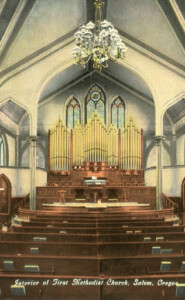First United Methodist Church
Following the precept of John Wesley to take the gospel to people everywhere, the Methodist Foreign Missionary Society sent a mission to the Indigenous peoples of the Pacific Northwest in 1833.
The next year the Reverend Jason Lee, Jason Lee’s nephew Daniel Lee and teacher Cyrus Shepard traveled overland to Fort Vancouver. At the urging of Hudson Bay Factor Doctor John McLoughlin, they selected a headquarters site in the Willamette Valley about ten miles north of the present city of Salem. Today this site is preserved as Willamette Mission State Park.
Regular church services began at the Mission in 1835, but it was not until 1841, when headquarters were moved to the Salem location, that the Methodist Episcopal Church of Salem was formally organized. Jason Lee was one of thirteen charter members and David Leslie became the first pastor.
The Church met for services in a room of the Oregon Institute. Coincidentally, the Mission families subscribed privately to establish the Oregon Institute (now Willamette University) to provide education for their children. The continuing vitality of these twin institutions, First Church and Willamette University, attest to the vision and faith of these pioneer missionaries.
The Mission served twelve stations in the Oregon Territory (at that time, all of the Pacific Northwest) until 1844 when much of the program was discontinued. However, most of the missionaries remained in Oregon. They were influential in the formation of the provisional government (1843 to 1848) which sought United States jurisdiction for the Pacific Northwest prior to the boundary settlement with Great Britain. Methodism was a stabilizing force throughout the territorial period.

Patton Post Card Company publisher, Color view of the interior of the First United Methodist Church showing the organ, two columns and a chandelier., WHC Collections 2011.006.0718
In 1852 the congregation of First Methodist Episcopal Church had a sufficient number of members to erect a modest building at the southeast corner of Church and State Streets. The service of dedication was celebrated on January 23, 1853. By 1870 both the congregation and the larger Sunday School had outgrown the small frame building. With the Bishop’s support, the congregation undertook the construction of the present sanctuary building. In spite of a national depression and other severe difficulties, the church with the tall white steeple was completed in 1878. Now both a Methodist landmark and an enrollee on the National Register of Historic Places, First United Methodist Church is cherished for its pioneer heritage.
Harmonious additions to the building were made in 1935 and 1967. In 1984 the original spire was replaced. The spire stands 185 feet above street level and is a Salem landmark. In 1953 the sanctuary was remodeled with the addition of the Findley Memorial Aeolian Skinner organ, a chancel rose window, new altar, pulpit, and pews. Interior renovations occurred in 1981 and 1988. The organ was completed with its full rank of pipes in 2000.
In 1992 the Elks building adjacent to First Church was purchased and renamed MICAH (Methodist Inner-city Community Activities House.) This former fraternal lodge now houses the Youth Center, the United Methodist Archives for the Oregon-Idaho Conference, an area for informal worship services, and several community outreach organizations.
Over the years First United Methodist Church helped establish four other Methodist churches in Salem and in 1998 became the location of the Northwest House of Theological Studies. As a downtown church, the congregation has joined with other denominations in community service, worship, and study. Most important, it is the spiritual home of a church family that ministers to its membership and community in a dynamic tradition.
Compiled by Harriet Schulbach and Jean Hand, First United Methodist Church.
Photographs provided by Harriet Schulbach and Jean Hand, First United Methodist Church.
This article originally appeared on the original Salem Online History site and has not been updated since 2006.







Leave A Comment